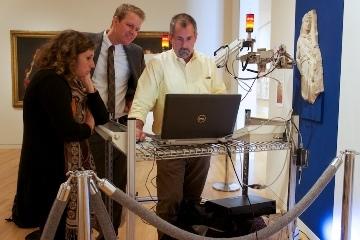
Section Branding
Header Content
UGA Finds Ancient Relief May Not Be Ancient
Primary Content

When you head to your favorite art museum, you may think the Greek and Roman statues there have always been spotless marble. But the University of Georgia is proving that wrong.
Art and chemistry students and professors are joining together to document that a 2,000 year-old marble relief was once vibrantly painted.
The first thing you notice when you walk into the second floor gallery of the Georgia Museum of Art in Athens are the beautiful wooden floors and works of art on the walls. But one object is out of place. To the left, a metal arm reaches toward a marble relief. It resembles a creature from the 1979 movie Alien.
Two men carefully move an arm toward the relief. On the end of the arm is a camera. It’s hovering over a 2,000 year-old fragment about two-and-a-half feet high. It’s a Roman marble relief from Athens, Greece.
“There’s some thought that the original context of this relief would have been a victory monument near the theater of Dionysus, which is where all the classic Athenian dramas were performed,” said Mark Abbe, Assistant Professor of Ancient Art at UGA .
This object is from the tale of Orpheus bringing Eurydice back from the underworld. Orpheus was a Greek hero who descended into Hades to bring back his love from the dead. These art historians and scientists are trying to prove that colored pigment once covered this cream-colored stone.
Museum curator Lynn Boland says this will be the first time the relief has been tested.
“This is a great example of one of these objects that’s been known for a long time and never been studied. It’s on loan from the University of Mississippi at Oxford. They were willing to lend it for this study, and we’re sharing all the results with them.”
The project will allow art and chemistry students at UGA to learn together using the alien- looking arm technology called x-ray fluorescence spectroscopy.
“We’re able to analyze areas that are about 80 microns diameter, or more or less twice the width of a typical human hair,” said Jeff Speakman with UGA’s Center for Applied Isotope Studies. “We can see the elements within that spot that then can inform the decisions about what is that composed of chemically.”
Speakman says the equipment has been around since the 1950’s but only in the last decade has it been portable enough to be used in a gallery. “Previously, when I was at the Smithsonian, I had a similar instrument and I’ve used it from everything from Thomas Jefferson’s bible to meteorites to Apollo space suits.”
Still, it will be difficult to determine what ancient pigments were on the Orpheus relief.
“I mean these things were underground for two plus millennia,” Speakman said. “So the paint that we have is extremely fragmentary. And many times it’s altered. The colors have actually shifted, so blue goes green, and yellow goes red.”
But for Greek art and architecture student Nadine Hernandez that helps bring art history to life. “Instead of just seeing it as a part of a ruin it gets us a little bit closer to the understanding of history,” she said.
If all goes well, in about six months researchers may be able to create a digital image of what the relief looked like 2,000 years ago.
The complete results of the recent study will be presented by Abbe and scientists from UGA in an interdisciplinary presentation "The Orpheus Relief: Object, Three Perspectives" at the Georgia Museum of Art March 28th.
Tags: University of Georgia, Orpheus Relief, historical reproduction, University of Mississippi
Bottom Content

